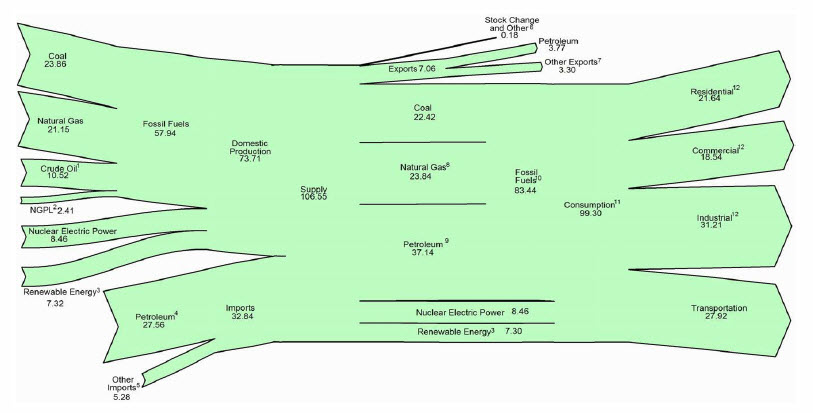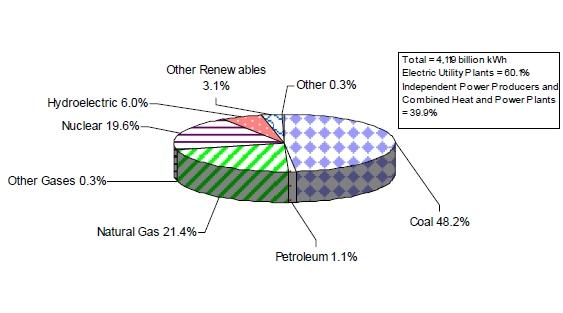by Catherine Haug
This coming Wednesday (June 23, 2010) we will be hosting a presentation by Jeff Arcel on Alternative Energy. It’s important when considering this topic to have a good understanding of where our electricity and fuels come from, how they are used in our society, and the true cost of energy use.
A few months ago I wrote a post on Alternative Energy and EROI (EROI is Energy Returned on Energy Investment) which discusses a pertinent topic. Now lets look at where our energy comes from and how it is used across our society.
Energy Production: Sources of Electrical Power
The following graphics reflect data from the Energy Information Administration (EIA). You can see that the amount of electricity from each source has changed over the years, but that overall, the bulk of our electricity comes form fossil fuels (coal, natural gas, and petroleum).
(Graphics from earthguide.ucsd.edu/fuels/electricity.html; Data from EIA)
(from EIA: Electric Power Industry 2008)
Uses of Energy
When we think of electricity consumption, we tend to think that our homes and businesses consume the largest chunk. When we think of fossil fuel consumption, we tend to think that transportation (cars, trucks, planes, trains, etc.) is the largest user. Are we right?
Lets look at some data from the EIA. The following graphic shows energy inputs (sources, as above) and outputs (uses) for 2008:. This interesting graphic shows quantities as BTUs (energy measure) for:
- inputs (energy sources such as coal, nuclear, etc) on the left,
- domestic outputs (uses such as residential, industrial, etc) on the right, and
- exports exiting in the middle
 (from EIA: Energy Flow 2008)
(from EIA: Energy Flow 2008)
Of all energy inputs in 2008, fossil fuels comprised the largest chunk at 84%, and the outputs (uses) were as follows:
- Industrial (plastics, farm chemicals, drugs, durable goods, etc), 31%
- Transportation (fueling cars, trucks, planes, rail, etc), 28%
- Residential (heating, lighting, etc), 22%
- Commercial (heating, lighting, etc), 19%
So, while we work on reducing our energy consumption at home and at the office, it is clear that we need to look more closely at how we use industrially-produced goods, because this sector is the largest single consumer of energy. We need to reduce our consumption of plastics, pharmaceuticals, processed foods and all other items that are industrially-produced, if we hope to curb our energy consumption.
Transportation
In his article from The American: Our Electric Future, Andy Grove opens with the following statement:
“Energy independence is the wrong goal. Here is a plan Americans can stick to.”
After showing how and why the goal of energy independence failed when Nixon was president, Mr. Grove suggests a conversion from fuel-powered to electric transportation is the real answer:
“We live in a world where just about everything—from a hairdryer to the Internet—runs on electricity. A big exception is the transportation sector, critical to the movement of people, production materials, food, and even fuel. Transportation uses more than half of all the petroleum consumed in this country. If we don’t convert a large portion of the transportation sector to electricity, we cannot make real progress toward energy resilience.”
He argues that a shift in focus from gasoline at the pump to electricity at alternative-powered batteries will not only move us away from our reliance on petroleum, but also reduce carbon emissions.
While this is definitely something we should consider, especially as electric mass transit, there are a few issues that are missed in the discussion. Here are three:
- Most of the electricity currently produced in the US is from burning fossil fuel (71% in 2008, per the EIA). So while your electric car may not directly consume a petroleum product, the electricity it uses likely comes from petroleum. Of course, a transition to alternative energy would change this.
- A change from auto to mass-transit for all travel other than within ones own community will go farther toward reducing our energy consumption than simply converting cars.
- Transportation is only one part (28%) of our overall energy needs (from the EIA Energy Flow diagram above).
References
- earthguide.ucsd.edu/fuels/electricity.html (this link no longer works)
- EIA: 2008 Energy Flow Diagram
- The American: Our Electric Future by Andy Grove
See also my articles:
